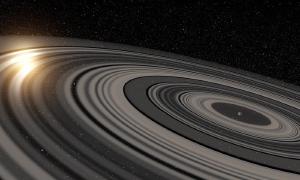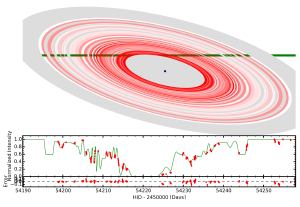Blog
Shadow of the Rings
27 January 2015
 Ron Miller
Ron MillerIn our solar system, the ring system of Saturn dwarfs all others. While such a large and complex ring system is rare for our solar system, it’s reasonable to presume that similar ring systems exist throughout the cosmos. We know, for example, that Saturn’s rings are stable against things like meteor impacts, and that they are likely as old as the planet itself. Now we know of at least one exoplanet with a large and complex ring system.
 Matthew A. Kenworthy, Eric E. Mamajek
Matthew A. Kenworthy, Eric E. Mamajekwith the ring model (green).
It is a planet known as J1407b, which is a brown dwarf that orbits a young sunlike star (J1407). In 2007 the star went through a series of eclipses, where something passed in front of it. Earlier studies of these eclipses hinted at the existence of a ring system around J1407b. As the planet passed near the star from our perspective, the rings of the planet occulted the star, causing it to vary in brightness over a period of more than 50 days. Now a new paper being published in the Astrophysical Journal confirms these rings.1 The new work also demonstrates that the ring system is complex, much like Saturn’s rings.
The team compared the occultation data with models of ring systems to determine the basic structure of the rings. They found it spans a distance 200 times that of Saturn’s rings, and contains about an Earth-mass of material. It even has what appears to be a large gap in the ring system. Such gaps are known to form in Saturn’s rings, for example, when a moon or moons clears its orbital path. If that’s the case for this gap, it could contain a moon somewhere between the size of Mars and Earth.
The J1407 system is only about 16 million years old, so it is quite possible that thing ring system is in the process of forming moons. If that’s the case the rings may gradually diminish as the moon system forms. For now, it is the greatest ringed planet we know.
Kenworthy, Matthew A., and Eric E. Mamajek. “Modeling giant extrasolar ring systems in eclipse and the case of J1407b: sculpting by exomoons?” The Astrophysical Journal 800.2 (2015): 126. ↩︎